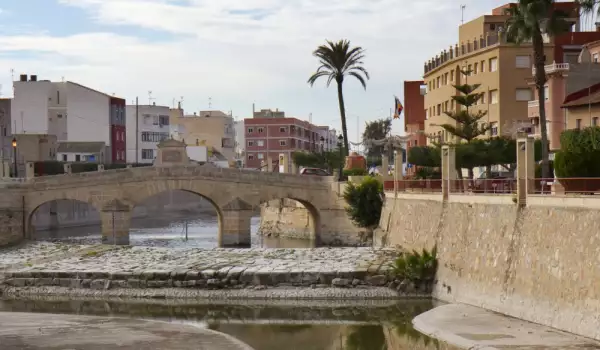Murcia

Murcia is a Spanish city located in the southeast. The city has a population of about 442 000 people and was founded in in 825. It is the capital of the autonomous region of Murcia. The city is famous for its centuries-old tradition in the production of fruits, vegetables and flowers. Murcia is famous for its festivals and its fabulous cuisine.
The city of Murcia was founded by the Emir of Cordoba - Abd ar-Rahman II.
Murcia is located near the center of the low-lying fertile plain known as the vineyards of Murcia. River Segura passes through the city. Murcia is surrounded by two mountain ranges - the Sierra de Orihuela and Cresta de Gallo. The city is divided by mountain ranges. It is believed that the name Murcia derives from the Latin word Myrtea, which means land of the myrtle. Another interpretation comes from the word Murta, which means mulberry, because for centuries the area was covered with mulberries. The Latin name is changed in Arab to Murcia.
Muslim designers of the city created a complex network of irrigation canals that turned the city into a prosperous agricultural center. After the fall of the Caliphate of Córdoba in 1031 and the fall of the Almoravid Empire, Murcia was the capital of the independent kingdom of Murcia. At that time, Murcia is a very prosperous city known for its pottery, silk and paper. In 1243 the city was colonized by Christians from almost all parts of the Iberya Peninsula. During the process of Christianization, many mosques in the city were destroyed or converted into Catholic churches.

Murcia flourished again in the eighteenth century, due mostly to the boom in the production of silk. In 1810 the town was devastated by the armies of Napoleon and then follows the great earthquake in 1829. During the earthquake over six thousand people were killed. Outbreaks of plague and cholera followed, which decimated much of the population. After them came the great flood caused by an increase in the level of the river Segura. Since 1838 the city was the capital of the province of Murcia and in 1982 became the capital of the autonomous community, which includes only the city and the province.
Among the landmarks of the city stands the Cathedral of Murcia, which was built in 1465 and decorated in Gothic style. The tower of the cathedral was completed in 1792. Because of construction in different centuries the cathedral is a mix of different architectural styles. The first two floors are influenced by the Renaissance and the third is entirely Baroque. The belfry has an impact on neoclassical and rococo. The main facade of the cathedral is considered a masterpiece of Spanish baroque style.
Other notable buildings are the cathedral of the Bishop's Palace, built in the eighteenth century, and the expansion of City Hall, completed in 1999.
The old town has many separate pedestrian zones that cover much of the area. Segura river is crossed by many bridges built in different styles. There is an old stone bridge from the eighteenth century, but also a modern iron bridge.
Among the landmarks of historical and cultural importance stands the monastery of Santa Clara and the sanctuary La Fuensanta. Romea Theatre was built in the nineteenth century and the palace Almudí was built in the seventeenth century and is a place where city records are kept and exhibitions are held.
In Murcia, a procession takes place during the Holy week. This traditional festival presents events that recreate the crucifixion according to the New Testament. After the Holy Week, the burial of the sardine is celebrated, which is a magnificent parade.







